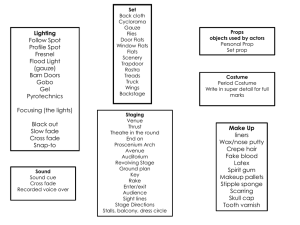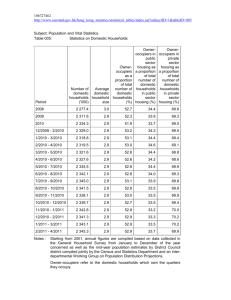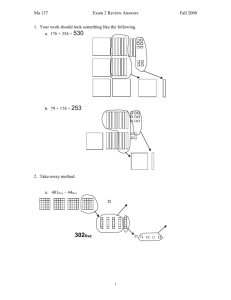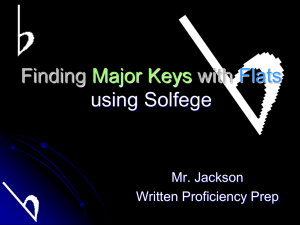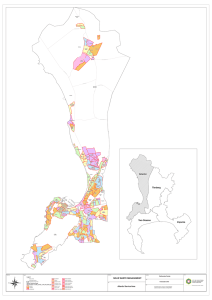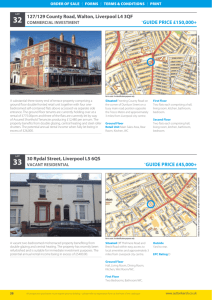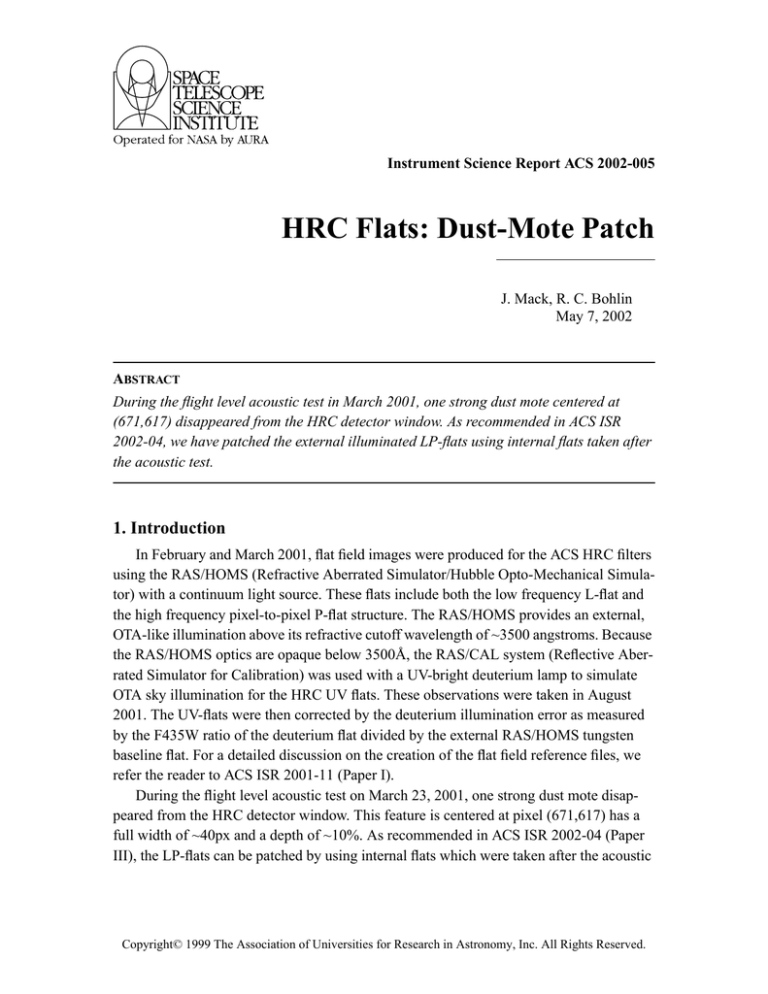
Instrument Science Report ACS 2002-005
HRC Flats: Dust-Mote Patch
J. Mack, R. C. Bohlin
May 7, 2002
ABSTRACT
During the flight level acoustic test in March 2001, one strong dust mote centered at
(671,617) disappeared from the HRC detector window. As recommended in ACS ISR
2002-04, we have patched the external illuminated LP-flats using internal flats taken after
the acoustic test.
1. Introduction
In February and March 2001, flat field images were produced for the ACS HRC filters
using the RAS/HOMS (Refractive Aberrated Simulator/Hubble Opto-Mechanical Simulator) with a continuum light source. These flats include both the low frequency L-flat and
the high frequency pixel-to-pixel P-flat structure. The RAS/HOMS provides an external,
OTA-like illumination above its refractive cutoff wavelength of ~3500 angstroms. Because
the RAS/HOMS optics are opaque below 3500Å, the RAS/CAL system (Reflective Aberrated Simulator for Calibration) was used with a UV-bright deuterium lamp to simulate
OTA sky illumination for the HRC UV flats. These observations were taken in August
2001. The UV-flats were then corrected by the deuterium illumination error as measured
by the F435W ratio of the deuterium flat divided by the external RAS/HOMS tungsten
baseline flat. For a detailed discussion on the creation of the flat field reference files, we
refer the reader to ACS ISR 2001-11 (Paper I).
During the flight level acoustic test on March 23, 2001, one strong dust mote disappeared from the HRC detector window. This feature is centered at pixel (671,617) has a
full width of ~40px and a depth of ~10%. As recommended in ACS ISR 2002-04 (Paper
III), the LP-flats can be patched by using internal flats which were taken after the acoustic
Copyright© 1999 The Association of Universities for Research in Astronomy, Inc. All Rights Reserved.
Instrument Science Report ACS 2002-005
test. The following report describes this correction and the steps required to match the
level of the internal flats to the RAS/HOMS flats at the boundary of the patched region.
2. Data
The internal flats are created using the ACS internal flat field calibration system and
have a slightly different illumination than the external flats. Specifically, the internal lamps
blur the shadows of the dust motes and cannot properly correct for new motes or for existing motes which may have shifted. Following the acoustic test, however, the dust mote in
question actually disappeared. The ACS launch did not cause any further particulate
migrations.
Table 1 summarizes the images used for patching the HRC flats. Both the tungsten 3
and tungsten 4 (T3 and T4) lamps are used for filters redward of 3500Å. For the UV filters, the original RAS/CAL external flats are used, with no deuterium illumination
correction. Since the RAS/CAL flats were taken after the disappearance of the (671,617)
dust mote and the external RAS/HOMS tungsten flats were obtained before the acoustic
test, this correction, which uses the F435W deuterium to RAS/HOMS tungsten ratio,
would actually reintroduce the dust mote onto the flat. While the global L-flat illumination
of the internal T3 and T4 flats and the external RAS/CAL flats each differ from the RAS/
HOMS flats, the pixel-to-pixel P-flat structure will be the same. ACS ISR 99-01 (Paper A)
compares the P-flat statistics of internal and external flats for three broadband filters. In
each case, the one-sigma rms scatter barely exceeds the counting statistics of the total
electrons recorded, so that the external and internal flats are the same to better than 0.2%
rms. Thus, with the appropriate normalization to match the external OTA illumination, the
internal flats will adequately serve as patch data.
To avoid any significant loss of signal-to-noise when applying the flat fields to the science data, the Poisson counting statistics of the external flats are in the 0.2 to 0.3% range,
i.e. at least 110,000 electrons per pixel (see Paper I). The same signal-to-noise is required
for the internal flats to be used as patches. For filters which did not have internal flats with
high enough signal-to-noise, we used a filter at an adjacent wavelength. For the blemish
free region at (590:690,434:534) on the HRC, Paper III demonstrated that the nearest
neighboring flats (in wavelength) have the same pixel-to-pixel P-flat structure to within
~0.2%.
2
Instrument Science Report ACS 2002-005
In Table 1, the source of the patch data for each HRC filter is listed in column 3, the
date of the patch observation in column 4, the ACS database entry number for each exposure in column 5, and the total signal (in units of 103 electrons per pixel) in column 6. For
the F502N, F550M, F658N, and F660N filters, the internal flats with the adjacent filter
given in column 2 are used for the patch. In Table 2, the statistics of these neighboring filters are calculated as in Paper III. The rms residual introduced by this using the adjacent
filters is between 0.1 and 0.2%, as shown in Table 2.
Table 1. Source of the dust mote patch for each HRC flat field. For four filters, adequate
signal-to-noise exposures were not available for the internal flats, and a neighboring filter
was used to patch the LP-flats.
Adjacent
Filter
Patch Used
Patch Source
Date of Patch
Observation
Patch Database
Entry Number
Signal in Patch
(103 electrons/pix)
F220W
RAS/CAL
2001 Aug 23
33999, 34000
101
F250W
RAS/CAL
2001 Aug 23
33997, 33998
78
F330W
RAS/CAL
2001 Aug 23
34002, 34003
75
RAS/CAL
2001 Aug 23
14
F435W
T4 Lamp
2001 Nov 06
34009, 34010
34011, 34012
35095, 35096
148
F475W
T3 Lamp
2001 Apr 04,Aug 02
28364, 32580
151
F555W
T4 Lamp
2001 Apr 03
28120, 28121
200
F606W
T3 Lamp
2001 Aug 02
32576
124
F625W
T4 Lamp
2001 Jul 13
31283, 31284
200
T3 Lamp
2001 Aug 02
32567
125
T4 Lamp
2001 Apr 03
270
F850LP
T3 Lamp
2001 Apr 04, Aug 02
28295, 28296
28297
28361, 32597
F892N
T3+T4 Lamps
2001 Apr 04, Aug 02
32575, 28312
114
Filter
F344N
F502N
F475W
F550M
F555W
F658N
F625W
F660N
F625W
F775W
F814W
3
177
Instrument Science Report ACS 2002-005
Table 2. Comparison of HRC flat field statistics and the pixel-to-pixel fine structure for
neighboring filters.
F502N
F550M
F658N
F660N
Poisson(%)
0.22
0.22
0.21
0.22
Actual sigma(%)
0.74
0.74
0.65
0.59
Sigma Flat(%)
0.71
0.71
0.62
0.55
Minimum
0.97
0.96
0.96
0.96
Maximum
1.10
1.10
1.11
1.11
F475W
F555W
F625W
F625W
Poisson(%)
0.23
0.22
0.22
0.22
Actual sigma(%)
0.85
0.78
0.64
0.64
Sigma Flat(%)
0.81
0.75
0.60
0.60
Minimum
0.96
0.96
0.96
0.96
Maximum
1.10
1.10
1.11
1.11
Poisson(%)
0.32
0.31
0.30
0.31
Actual sigma(%)
0.36
0.33
0.32
0.32
Resid. sigma(%)
0.17
0.12
0.09
0.08
NUMERATOR
DENOMINATOR
RATIO
3. Normalization
The small rectangular region (652:690,596:638) suggested in Paper III is used to
replace the dust mote feature in the LP-flats. For F606W and longer wavelength filters, a
slightly larger region (650:692,595:642) is required to mask the dark ring surrounding the
dust mote.
In Figure 1, the top-left panel shows the original F475W RAS/HOMS LP-flat, centered on the dust mote at (671, 617). In the top-right panel, the tungsten 3 internal flat has
been cut and pasted directly into the desired region of the external flat. While the pixel-topixel structure is the same, a normalization is required to match the flats at the boundary of
the patched region. This requires a fit, both in the x and y directions, to eliminate any discontinuity across the flat. Any offset would cause a discontinuity in ACS images which
have been calibrated using the patched flat fields.
4
Instrument Science Report ACS 2002-005
Figure 1: F475W Dust Patch. The top-left panel shows the RAS/HOMS LP-flat, centered
on the (671, 617) dust mote. The top-right panel shows the internal flat, spliced into the
region (652:690,596:638). The internal flat is then normalized to match RAS/HOMS flat
in the y-direction (lower-left) and in the x-direction (lower-right). The image stretch is
from 0.98 (white) to 1.01 (black). The flat field values of the original dust mote are all
white at this stretch, but are as low as 0.90 at the center of the ring.
Figure 2 illustrates the fitting which has been applied to match the external and internal flats at the location of the patch. The top panel is the average of columns 652:690 and
shows the shape of the illumination in the y-direction of the flat. The solid line corresponds to the upper-right panel in Figure 1. The discontinuity in the RAS/HOMS curve
occurs where internal lamp flat has been spliced into the patch region. To appropriately
scale the internal flat, the ratio of the external to internal flats is determined at the left and
right edges of the patch rectangle. Then, a linear fit is applied as a function of row number
to align the two flats. The result is the dashed line which corresponds to the lower-left
image in Figure 1. While the flats now are continuous in the y-direction, a clear discontinuity is still apparent in the x-direction.
5
Instrument Science Report ACS 2002-005
Figure 2: The average of columns 652:690 (top panel) and the average of rows 596:638
(bottom panel) in the RAS/HOMS flat, where the internal lamp flat has been spliced into
patch region (solid line). A linear fit has been applied to align the flats in the y-direction
(dashed line). A fit in both the y- and the x-directions is required to align the external and
internal flats at the patch boundary (dotted line).
6
Instrument Science Report ACS 2002-005
The bottom panel in Figure 2 is the average of rows 596:638 and illustrates the shape
of the illumination pattern in the x-direction of the flat field. Again, the dashed line shows
the correction resulting from a fit in the y-direction only. Although it is much smaller, a
discontinuity still exists at the boundary. A second linear fit, this time in the x-direction, is
then applied as a function of column number to align the two flats. The result is plotted
with a dotted line and corresponds to the lower-right panel of Figure 1.
The values in the associated error array of the internal flat will not match the RAS/
HOMS error in the region of the patch. Because the statistical uncertainty is determined
from the total signal in electrons in the source image, the error will implicitly be different
for each flat.
4. Future Patches
Subsequent reports will describe the patches required for the HRC filters in combination with the polarizers and with the coronograph. Recent data indicates, however, that the
coronographic spots, which were originally aligned with the Fastie occulting finger, have
shifted to the right by ~50 pixels and down by ~10 pixels following gravity release. The
HRC coronograph flats cannot be patched simply using the internal lamp flats but must
utilize exposures of the bright earth or other suitable astronomical source.
References
Bohlin, R. C., Hartig, G., Lindler, D. J. Meurer, G., & Cox, C. 1999, Instrument Science Report, ACS 99-01, Paper A, (Baltimore:STScI).
Bohlin, R. C., Hartig, G., & Martel, A. 2001, Instrument Science Report, ACS 01-11,
Paper I, (Baltimore:STScI).
Bohlin, R. C. & Hartig, G. 2002, Instrument Science Report, ACS 02-01, Paper II,
(Baltimore:STScI).
Bohlin, R. C. & Hartig, G. 2002, Instrument Science Report, ACS 02-04, Paper III,
(Baltimore:STScI).
7


